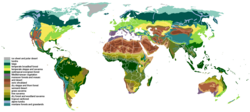Population density
The population density of a country or city or other place is a number showing how crowded that place is. It is got by dividing the population by the area. For example, France has a population of 60,561,200, and an area of 551,695 square kilometres, so its population density is about 109.8 persons per square kilometre.
A number of factors affect population density. For example, the climate. Greenland has a very low population density because people cannot live on its large glacier (ice sheet) or survive in such frigid temperatures.
Many cities are near rivers, because the first settlers wanted somewhere close to water to start a society. Areas around rivers often have a high population density.
The population density of New York City is 10,292 persons per square kilometre. Other places, such as large countries, can have very low population densities. The population density of Canada is only 3.8 persons per square kilometre because it is such a big country.
The country with the highest population density in the world is Monaco, with 16,620 persons per square kilometre. The country with the lowest is Greenland, which has only 0.03 persons per square kilometre.
+{{{1}}}−{{{2}}}
Population Density Media
Population density (people per square kilometre) map of the world in 1994.In relation to the equator it is seen that the vast majority of human population lives in the Northern Hemisphere, where 67% of Earth's land area is.
Mongolian Steppes. Mongolia is the least densely populated country in the world due to its harsh climate as a result of its geography.
Monaco is currently the most densely populated nation in Europe.
This population cartogram of the European Union (2007–2012) uses areas and colors to represent population.
Related pages
References
- ↑ Diaz, A. Mongolia: a transitional society and the consequences for adolescent health. Pacific Health Dialog 5.2 (1998).
- ↑ 2.0 2.1 Kraehnert, Kati, and Claudia Kemfert. Consequences of extreme weather events for developing countries based on the example of Mongolia. DIW Weekly Report 8.40 (2018): 367-368.










